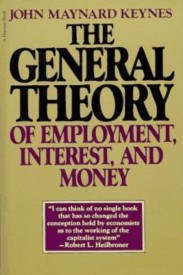Krugman vs Kelton on the fiscal-monetary trade-off
The loanable funds fallacy – Lars Syll

The US economist Paul Krugman is back again telling us that he doesn’t really want to spend time on arguing about MMT — and then complains that well-known MMT economist Stephanie Kelton says things “obviously indefensible”. The self-proclaimed ‘conventional’ Keynesian is especially irritated that Kelton “seems to claim that expansionary fiscal policy … will lead to lower, not higher interest rates.”
The logic of Krugman’s “conventional Keynesian” loanable-funds IS-LM- theory is that if the government is going to pursue an expansionary fiscal policy it will have to borrow money and there- by increase the demand for loanable funds which will — “other things equal” — lead to higher interest rates and less private investment.
The loanable funds theory is in many regards nothing but an approach where the ruling rate of interest in society is — purely and simply — conceived as nothing else than the price of loans or credits set by banks and determined by supply and demand in the same way as the price of cars and raincoats.
It is a beautiful fairy tale, however the problem is that banks are not barter institutions that transfer pre-existing loanable funds from depositors to borrowers. Why? Because, in the real world, there simply are no pre-existing loanable funds. Banks create new funds – credit or deposit money – whenever people they do business with require payment. Banks are therefore monetary institutions, not barter vehicles.
In the traditional loanable funds theory – as presented in Krugman’s textbooks – the quantity of loans and credit money available for financing investment is constrained by the quantity of available savings. According to this narrative, saving represents the supply of loan- able funds, while investment represents the demand for loanable funds and is assumed to be negatively related to the interest rate.
The loanable funds theory in the ‘New Keynesian’ approach means that the average interest rate is endogenized by assuming that Central Bank can (try to) adjust it in response to an eventual out- put gap. This, of course, is essentially nothing but an assumption of Walras’ law being valid and applicable, and that a fortiori the attainment of equilibrium is secured by the Central Bank’s interest rate adjustments. From a Keynes-Minsky-MMT point of view, this can be considered to be a belief resting on nothing but sheer hope.
The traditional loanable funds theory is that it assumes that saving and investment can be treated as independent entities. According to Keynes, this is seriously wrong:
“ The classical theory of the rate of interest [the loanable funds theory] seems to suppose that, if the demand curve for capital shifts or if the curve relating the rate of interest to the amounts saved out of a given income shifts or if both these curves shift, the new rate of interest will be given by the point of intersection of the new posit- ions of the two curves. But this is a nonsense theory. For the assumption that income is constant is inconsistent with the assumption that these two curves can shift independently of one another. If either of them shifts, then, in general, income will change; with the result that the whole schematism based on the assumption of a given income breaks down … In truth, the classical theory has not been alive to the relevance of changes in the level of income or to the possibility of the level of income being actually a function of the rate of the investment. “
Savers and investors have different liquidity preferences and face different choices – and their interactions usually only take place by the intervention of financial institutions. This, importantly, also means that there is no ‘direct and immediate’ automatic interest mechanism at work in modern monetary economies. What happens at the microeconomic level is not always compatible with the macroeconomic outcome. The ‘atomistic fallacy’ has many faces – the loanable funds story being one of them.
We have to free ourselves from the loanable funds theory – and scholastic gibbering about ZLB – and start using good old Keynesian fiscal policies.
Keynes – along with Lerner, Kaldor, Kalecki, and Robinson – showed that it was possible to promote economic development with an “appropriate size of the budget deficit.” The stimulus that a well-functioning fiscal policy aimed at full employment may have on investment and productivity does not necessarily have to be offset by higher interest rates.

Source. Real World Econ Rev, 1 Mar 2019 https://rwer.wordpress.com/2019/03/01/krugman-vs-kelton-on-the-fiscal-monetary-tradeoff/



























